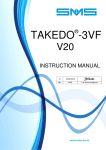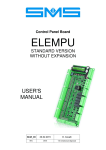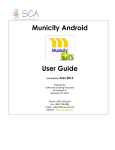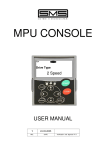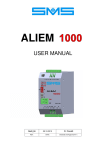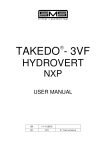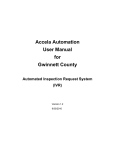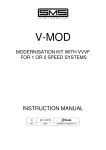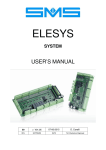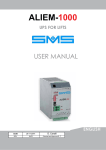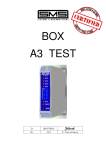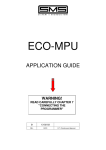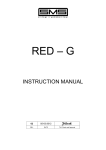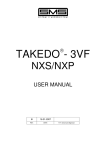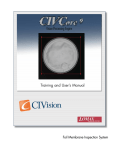Download User manual (V20 type)
Transcript
TAKEDO - 3VF
HYDROVERT
V20
USER MANUAL
1
17-11-2014
D. Cavalli
REV.
DATE
Check and Approval R.T.
INDEX
12345678910 -
INTRODUCTION
RECOMMENDATIONS AND PRECAUTIONS
CONNECTION OF THE POWER CIRCUIT
CONTROL CIRCUITS
BASIC APPLICATION DRAWING
Page
Page
Page
Page
Page
3
3
4
5
6
5.1 – OIL TEMPERATURE MEASUREMENT PROBE
Page
7
KEYBOARD AND PROGRAMMING
MONITOR MENU
PARAMETERS MENU
FAULTS MENU
ADJUSTMENT PROCEDURE
Page
Page
Page
Page
Page
8
9
10
12
14
10.1 – UPWARD RUN Adjustments
10.2 – UPWARD START Adjustments
10.3 – UPWARD STOP Adjustments
10.4 – RE-LEVELLING Adjustments
10.5 – MAXIMUM INPUT POWER Adjustments
Page
Page
Page
Page
Page
14
15
15
16
16
Page
Page
Page
17
18
19
11 - CONTROLS AND MAINTENANCE
12 - DIMENSIONS AND FIXING
VACON DECLARATION OF CONFORMITY
2
HYDROVERT V20 USER MANUAL Version 1 dated 17-11-2014
1 – INTRODUCTION
HYDROVERT V20 is a new inverter model with built-in EMC filter in compliance with 2004/108/EC
(Electromagnetic Compatibility) and 2006/95/EC (Low Voltage) Directives, fitted with special software for
hydraulic plants, which can operate with both old and new control units.
Controls only the UPWARD run phase.
The following advantages are attained:
•
•
•
•
•
•
No peak currents. The maximum start-up current is the nominal current.
Possibility of setting a network maximum input power limit, to contain the contractual power.
Reduction of consumptions.
Optimisation of run comfort.
Power factor correction of the network input power. Cosϕ
ϕ 0.98.
Possibility of selecting the inspection speed value.
HYDROVERT V20 is available for motors with maximum input current up to 27A.
A TABLE is given successively, which states the indicative INPUT POWER and POWER ENGAGED values
that can be obtained with HYDROVERT V20, highlighting the possible saving with respect to the application
of a simple SOFT STARTER.
MOTOR DATA
INPUT POWER
(kW)
With
With
NOMINAL
MAXIMUM
current
current
PLATE
POWER
(kW)
NOMINAL
CURRENT
(A)
MAXIMUM
CURRENT
(A)
2.2
7.1
9
3.9
3
8.6
11
4.7
13
6
15
POWER ENGAGED
(kW)
SOFT
STARTER
HYDROVERT
5
6
4.5
4.7
6
6
4.5
16
7.2
8.8
10
6
21
8.3
11.6
15
6
TABLE 1 – Input Power and Engaged Power
2 – RECOMMENDATIONS AND PRECAUTIONS
For everything that concerns the recommendations relative to personal safety and to prevent accidental
damage to the product or equipment connected to it, refer to the “SAFETY” chapter in the original
VACON INSTALLATION AND MAINTENANCE TECHNICAL MANUAL (VACON 20 Cold Plate series
inverter) available at www.it.vacon.com, where the “Declaration of Conformity”, given on the last page of
this document, is also present.
Read this manual completely before powering the appliance.
Regarding specific application on elevators, also carefully consider the following points:
1- The inverter leakage current to earth is over 30mA, a residual current device must therefore be
envisioned with Id no less than 300mA; type B or type A. For the earth connection, the regulations
prescribe a cable with minimum section of 10 mm².
If, on closing the master switch, the RCD intervenes, do not repeat the manoeuvre several times
successively because the inverter could undergo permanent damage.
2- To prevent damage to the inverter in the event of prolonged standstill without power supply,
before re-starting it is necessary:
- If the inverter is at a standstill for several months, power it for at least 1 hour in a way to
regenerate the bus condensers.
- If the inverter is at a standstill for more than 1 year, power it for 1 hour with voltage that is 50%
lower than the nominal voltage and then for 1 hour at nominal voltage.
HYDROVERT V20 USER MANUAL Version 1 dated 17-11-2014
3
3 – CONNECTION OF THE POWER CIRCUIT
L1;L2;L3
Network power supply input
U;V;W
Inverter outlet
Earth
Connect the three power supply network input phases,
independently of the cyclic direction.
Connect the three output phases to the contactors and
therefore to the motor
Connect to the plant earth
For the dimensioning of the cables and the position of the clamps, refer to the “POWER CONNECTIONS”
chapter in the original VACON INSTALLATION AND MAINTENANCE TECHNICAL MANUAL (VACON 20
Cold Plate series inverter) available at www.it.vacon.com.
HYDROVERT V20 400 VOLT
RATED
CURRENT
(A)
MAXIMUM
CURRENT
(A)
CODE
DIMENSIONS
LxHxD
(mm)
FUSES
gG/gL
(A)
18
19.6
HVV00184
175x275x140
20
27
29,7
HVV00274
175x275x140
25
TABLE 2 – Currents and fuses for 400V power supply voltage
4
HYDROVERT V20 USER MANUAL Version 1 dated 17-11-2014
4 – CONTROL CIRCUITS
Number
1
2
3
4
5
6
7
8
9
10
11
Description
Control Clamps A-20
Clamps STO
Relay Clamps
Optional Board Clamps
Jumpers STO
DIP Switch:
SW1 in position 0, the digital inputs common (8-10 and 14-16)
is connected to earth (pre-defined position);
in position 1, the above-mentioned common is isolated from earth.
SW2 analogue input operation AI1;
SW3 analogue input operation AI2;
in position 0, the analogue input selected works in current;
in position 1, the analogue input works in voltage;
the voltage range is 0…10V and current range is 0/4…20mA.
SW4 used for the termination of the bus in the RS485 connection;
in position 0, the termination resistance is connected;
in position 1 no (pre-defined position).
Status LED:
“PWR” Orange the inverter is powered by the network
“RUN” Green
the inverter is in operating mode
“FLT” Red
the inverter has an anomaly
“RDY” Orange the inverter is READY and there are no anomalies
it flashes when an alarm is triggered
HMI RJ45 connector for control panel (Keyboard/PC)
Braking Resistance Clamps (not used for this application)
Power supply connector for fan
A-20 echo connector
HYDROVERT V20 USER MANUAL Version 1 dated 17-11-2014
5
6
T
S
TP
SHIELDED CABLE
THREEPHASE
LINE
400V
R
INSPECTION
TP1
HYDROVERT V20 USER MANUAL Version 1 dated 17-11-2014
TEMPERATURE
PROBE
1000Ω 0°C
1K2 1/4W
E-ENABLE
V-SPEED (HIGH/LOW)
S-UPWARD
SHIELDED CABLE
3
2
1
16
RO2
RO1
HYDROVERT
V20
L1-N for the
230V single-phase
connection
6 24Vdc
10
9
8
L3
L2
L1
26
25
23
22
W
V
U
SHIELDED CABLE
TP1
EARTH CABLE
TP
CONTACTORS
SHIELDED CABLE
SHIELDED
CABLE
M
3-PH
INVERTER CONTACT “OK”
Imax< 400mA DC; Vmax<=125 Vdc
(see IMPORTANT! note in the box)
CONTACTORS
AND UPWARD/HIGH SPEED VALVE
COMMAND
Imax< 400mA DC; Vmax<=125 Vdc
SHIELDED
CABLE
5 – BASIC APPLICATION DRAWING
IMPORTANT!
During the UPWARD run, the HIGH
SPEED electro-valve must be powered
for the entire duration of the run, up to the
end of the electrical stop at the floor
(e.g. through an auxiliary switch of the run
contactors).
5.1 – OIL TEMPERATURE MEASUREMENT PROBE
ASSEMBLY OF THE PROBE INSIDE THE HYDRAULIC CONTROL UNIT
Immerse the bulb of the control unit oil probe, paying attention that it does not touch the bottom but remains
in the oil bath even with the cabin at the extreme top floor.
INVERTER SETTINGS
The ANALOGUE input 1 (clamp 2), must be configured in “VOLTAGE”:
Switch SW2 in position 1
Connect the probe as indicated in the layout
To set the relative parameters, see Paragraph 10.3, points 4 ÷ 11.
HYDROVERT V20 USER MANUAL Version 1 dated 17-11-2014
7
6 – KEYBOARD AND PROGRAMMING
The programming keyboard is the interface between
HYDROVERT V20 and the user and must be connected to
the connector shown in the figure, via the cable supplied.
The keyboard can be used to control the state of the motor and the inverter and modify the parameters.
The KEYS section is illustrated in the following figure:
Go backward through menus.
Exit from the modification
mode. Hold down to reset the
FAULTS
Scroll the menu upwards.
Modify the values,
increasing them.
NOT USED
Move the cursor to the left
Move the cursor to the
right
NOT USED
Scroll the menus downwards.
Modify the values,
decreasing them.
NOT USED
Enter the level or active item.
Confirm the selection.
The DISPLAY section indicates the status of the motor and inverter, including any irregularity in operation of
the same.
It is possible to see the information regarding the current position inside the menu and the item displayed.
STATUS
indicators
ALARM or FAULT
indicators
MENU
indicators
8
DIRECTION
CONTROL POSITION
indicators
indicators
HYDROVERT V20 USER MANUAL Version 1 dated 17-11-2014
6.1 – MENU STRUCTURE
On the keyboard, the data is divided into Menus.
• Use UP ARROW and DOWN ARROW to scroll the menus.
• Enter the desired group by pressing the OK key and go back to the previous level by pressing the
BACK/RESET key.
The arrow on the left of the display indicates the active menu.
The MAIN MENU has the following structure:
Reference from Keyboard
(REF)
Monitor
(MON)
Parameters
(PAR)
Faults
(FLT)
(divided into ACTIVE FAULTS and FAULTS MEMORY)
6.2 – USING THE KEYBOARD
6.2.1 DATA MODIFICATION
To modify the value of a parameter, follow the procedure below:
1. Identify the parameter
2. Press OK to enter the MODIFICATION mode
3. Set the new value using the UP and DOWN ARROWS.
The value can also be modified number by number, moving from one to another using the RIGHT
and LEFT ARROWS.
4. Confirm the modification using the OK key
(or ignore the modification and go back to the previous level by pressing the BACK/RESET key).
6.2.2 RESET FAULTS
When a FAULT appears and the inverter blocks, analyse the causes that led to the intervention of the
protection function with the help of the TABLE in Chapter 9.1 – ACTIVE FAULTS, then restore operation by
pressing and holding the BACK/RESET key.
7 – MONITOR MENU
This menu allows to display values and data during operation of the inverter and is divided into 2 sub-menus.
Index
Description
Index
Description
Output frequency
Frequency Reference
Motor shaft speed
Motor current
Motor torque
V1.6
V1.7
V1.8
V1.9
V1.10
Motor power
Motor voltage
Motor temperature
Final output frequency
Actual Power
RO1
Contactors
1 – Motor
V1.1
V1.2
V1.3
V1.4
V1.5
2 – Inverter
RO2
Inverter “OK”
V2.1
DC-link voltage
V2.7
V2.2
V2.3
Unit temperature
Board temperature
V2.8
V2.9
Analogue output
Anticipated contactors openings
V2.4
DI1
Upward
DI2
Speed (High/Low)
DI3
Enable
V2.10
Not Used
(clamp 8)
(clamp 9)
(clamp 10)
V2.11
Analogue Input 1
V2.12
Analogue Input 2
(clamps 22-23) (clamps 25-26)
V2.5
V2.6
DI4
DI5
Downward Emergency
DI6
Inspection
(clamp 14)
(clamp 15)
(clamp 16)
DI7
DI8
DO1
Inverter “READY”
(clamps 6-20)
STO
(clamp 2)
(clamp 4)
------------ NOT USED -----------
(clamp STO)
HYDROVERT V20 USER MANUAL Version 1 dated 17-11-2014
9
8 – PARAMETERS MENU (Default values for 400V series)
Index
Description
1 – BASIC PARAMETERS
Unit
Default
P1.1
P1.2
P1.3
P1.4
P1.5
P1.6
P1.7
P1.8
A
V
Hz
rpm
A
400
50
2800
Current limit
Motor nominal voltage
Motor nominal frequency
Motor nominal speed
Motor nominal current
Motor φ cos
Identification
Maximum power
kW
(**)
(*)
0.80
0
15
2 – CONFIGURATION
P2.1
P2.2
P2.3
P2.4
P2.5
P2.6
P2.7
P2.8
P2.9
P2.10
P2.11
P2.12
P2.13
P2.14
P2.15
P2.16
P2.17
P2.18
P2.19
P2.20
P2.21
P2.22
P2.23
P2.24
P2.25
P2.26
Pre-start ramp
Pre-start frequency
Pre-start time
Acceleration time
Deceleration time
High speed
Low speed
Levelling speed
Inspection speed
Final deceleration time
Ramp shape
Losses compensation
No-load current
Max load current
Load compensation
Oil temperature compensation
Power measure %
Power measure Hz
Current increment with speed
Decel time correction in power limit
Minimum load threshold
Short floor speed
Levelling compensation minimum
Levelling compensation maximum
Levelling minimum current
Levelling maximum current
Hz
s
s
s
Hz
Hz
Hz
Hz
s
s
rpm
A
A
Hz
Hz
%
Hz
%
%
%
Hz
Hz
Hz
A
A
0.2
2.00
0,1
1,5
2,0
50
7
7
25
0,5
2,00
0
(*)
(*)
2
0
150
20
30
120
50
20
0
1
(*)
(*)
3 – DRIVE CONTROL
P3.1
P3.2
P3.3
P3.4
P3.5
P3.6
P3.7
P3.8
P3.9
P3.10
P3.11
P3.12
P3.13
P3.14
P3.15
P3.16
P3.17
P3.18
P3.19
P3.20
Brake chopper
Brake chopper threshold
Motor control mode
Switching frequency
Torque boost
U/f ratio selection
Field weakening point
Voltage at field weakening point
U/f curve midpoint frequency
U/f curve midpoint voltage
Output voltage at zero frequency
Identification current
Motor stator voltage drop
Low switching frequency
Change switching frequency threshold
Low noise modulator
Power limit correction
Current 2nd read delay
Power limit mode
Stable current window
V
kHz
Hz
%
Hz
%
%
%
%
kHz
Hz
%
s
0
0
1
8.0
1
2
50
100
1.75
5.00
3.50
50
0.00
5.0
5.00
1
100
0,5
1
0,20
(*) The value depends on inverter size and is set on the basis of the type of motor and plant.
(**) The value depends on the inverter size.
10
HYDROVERT V20 USER MANUAL Version 1 dated 17-11-2014
Value
Index
Description
4 – INPUT SIGNALS
P4.1
P4.2
P4.3
P4.4
P4.5
P4.6
P4.7
P4.8
P4.9
Unit
Upward start
Downward start
High speed
Inspection speed
Run enable
Emergency
A3 mode door
A3 mode bottom floor
Short floor
Default
1
4
2
6
3
5
Value
(DI1)
(DI4)
(DI2)
(DI6)
(DI3)
(DI5)
0
0
0
5 – OUTPUT SIGNALS (see BELOW for CONFIGURATION)
P5.1
P5.2
P5.3
P5.4
P5.5
P5.6
P5.7
P5.8
P5.9
P5.10
P5.11
P5.12
P5.13
P5.14
P5.15
P5.16
P5.17
P5.18
Relay output 1 content
Relay output 2 content
Digital output 1 content (Open Collector)
Analogue Output digital function content
Relay output 1 ON delay
Relay output 1 OFF delay
Relay output 1 inversion
Relay output 2 ON delay
Relay output 2 OFF delay
Not Used
Not Used
Not Used
Analogue output function
Analogue output minimum
Analogue output scale
Analogue output filter time
Frequency supervision 1
Frequency supervision value 1
s
s
s
s
%
s
Hz
3
1
1
1
0.00
0.00
0
0.00
0.00
0
0
100.0
0.0
1
30.00
6 – PROTECTIONS
P6.1
P6.2
P6.3
P6.4
P6.5
P6.6
P6.7
P6.8
P6.9
P6.10
P6.11
P6.12
P6.13
P6.14
P6.15
Earth fault protection
Motor stall protection
Motor stall delay
Motor stall minimum frequency
Thermal protection of the motor
Motor ambient temperature
Motor cooling factor at zero speed
Motor thermal time constant
Response to thermistor fault
Maximum contactor fault numbers
STO Alarm
Response to input phase fault
Input phases fault max. ripple
Enable OFF check
Parameters lock
s
Hz
C
%
M
2
0
5.0
15.00
0
40
40.0
45
2
20
1
0
0
1
0
CONFIGURATION OF DIGITAL OUTPUT SIGNALS
The digital outputs (relays, Open Collector) and the analogue output used as digital (P5.1 ÷ P5.4) can
assume the following functions:
0 = Fault
4 = Frequency supervision
1 = Ready
5 = Upward start
2 = Valve 1
6 = Valve 2
3 = Motor contactors
7 = No Fault
NOTE: When an output is programmed as frequency supervision (e.g. to control motor speed), the
parameters that indicate the output switching values are:
P5.17 = 0 No supervision
= 1 Output ON at frequency lower than P5.18 (Default)
= 2 Output ON at frequency higher than P5.18
P5.18 = Frequency value at which switching takes place (Default = 30Hz)
HYDROVERT V20 USER MANUAL Version 1 dated 17-11-2014
11
Index
Description
7 – AUTORESET
P7.1
P7.2
P7.3
P7.4
Automatic restart
Trial time
Wait time
Automatic restart trials
Unit
Default
s
s
1
60.0
3.0
3
Hz
kHz
5.00
3.0
C
C
%
%
%
%
Hz
Hz
Hz
1
10
70
80
46
54
50
0.00
0.00
0.00
M
M
s
M
s
s
0
240
1
5
480
0.15
0.15
Value
8 – EVACUATION
P8.1
P8.2
Maximum frequency
Switching frequency
9 – TEMPERATURE
P9.1
P9.2
P9.3
P9.4
P9.5
P9.6
P9.7
P9.8
P9.9
P9.10
Oil temperature measure
Initial inverter min. temperature
Initial inverter max. temperature
Initial motor max. temperature
Min. analogue signal
Max. analogue signal
Zero analogue signal
T Min compensation
T Max compensation
T Zero compensation
10 – AMENDMENT A3
P10.1
P10.2
P10.3
P10.4
P10.5
P10.6
P10.7
Logic A3 active
Check interval
Closed door time + bottom floor time
Valves activation time
Check time out
EV1 ON delay
EV2 OFF delay
9 – FAULTS MENU
ACTIVE FAULTS and the FAULTS MEMORY are found in this MENU.
9.1 ACTIVE FAULTS
When a fault occurs, the display shows the relative code flashing.
The most common fault messages are listed below. Do not restore the alarm or the fault before having
analysed the causes that have led to the intervention of the protection function.
Always remove the run command before resetting the fault.
Press and hold the BACK/RESET key to restore operation.
9.2 FAULTS MEMORY
The last 10 faults occurring are stored in the FAULTS MEMORY.
Select the FLT Menu, moving the indicator on the left, an S will appear.
Press OK and then the LEFT arrow until F6.1 is displayed: this is the first fault in the memory, i.e. the last
that occurred in time. Press OK to display the KEY.
Press BACK/RESET to go back to F6.1 and then DOWN ARROW to pass to the successive fault F6.2, and
so on to scroll all faults memorised.
12
HYDROVERT V20 USER MANUAL Version 1 dated 17-11-2014
Fault
Code
Description
1
Overcurrent: The inverter has detected a current that is too high.
2
5
Overvoltage: The DC intermediate circuit voltage has exceeded the limits envisioned.
Earth fault: The measurement of the current has detected that the sum of the motor phases
currents is different to 0, therefore there is a possible current to earth.
Load contact: The load contact is open when the START command is active.
8
System fault: Component fault. Faulty operation. No braking resistance connection.
9
Undervoltage: The DC intermediate circuit voltage is below the envisioned voltage limits.
Output phases: No current on one or more output phases.
The test is performed 3 times, on the 4th it goes into FAULT mode
Inverter undertemperature: The temperature of the heat dissipater is below –10°C.
3
11
13
17
Inverter overtemperature: The temperature of the heat dissipater is above 90℃.
Motor stall: The motor stall protection has triggered.
Motor overtemperature: The inverter motor temperature model has detected overheating of the
motor. The motor is presumably overheated.
Motor underload: The motor underload protection has triggered.
22
"checksum" error: Parameters recovery from EEPROM failed. C
omponent fault.
24
Meter fault: The value displayed by the meters is incorrect.
25
"Watchdog" fault: Microprocessor fault.
34
Internal bus communication
39
Device removal: The optional board or the power unit has been removed.
40
44
Device unknown: Optional board or power unit unknown.
IGBT temperature: The IGBT overtemperature protection device has detected a short term
overload current that is too high (motor loaded that does not start).
Device modification: The optional board has been changed.
45
Device addition: The optional board has been added.
50
60
The corresponding current of the analogue input is < 4mA.
Panel communication fault: The connection between the command panel and the inverter is
interrupted.
Field bus fault:
The data connection between the field bus Master and the board is interrupted
Advanced stop with respect to low speed: The cabin reaches the floor when it is still decelerating
61
Current low.
62
Enable lost during run.
63
Output phases: No current on one or more output phases.
64
Reference low
65
Time out enable: The enable command did not fall after 3” from the fall of the contactors
command.
14
15
16
41
52
53
67
*68
69
71
NOTE
Alarm 68
Overspeed: Due to an anomaly, the inverter exceeds the maximum frequency.
Advanced contactors opening: (See Alarm 68 NOTE)
The contactors between inverter and motor opened before inverter switch off.
No Enable: Indicates that the contactors closed signal is not activated (input 10) within 2 sec. from
the contactors command (clamps 22-23 output).
Identification not occurred: The procedure was not successful.
Check the connection between inverter and motor.
After 20 interventions of this alarm, the lift system goes out of service and the RESET key must be
pressed to restore operation.
Eliminate the problem by verifying what causes the advanced opening of the contactors.
If the problem remains, contact SMS assistance.
CONTINUOUS INTERVENTION OF ALARM 68, CAN CAUSE THE INVERTER TO BREAK.
HYDROVERT V20 USER MANUAL Version 1 dated 17-11-2014
13
10 – ADJUSTMENT PROCEDURE
Before making any adjustment or modification to the parameters, proceed as follows:
1 – Enter the motor plate data into parameters P1.1/2/3/4/5/6.
2 – Make an upward command and check that the motor turns in the correct direction.
3 – PERFORM THE AUTO-TUNING ROUTINE VIA PARAMETER P1.7 – IDENTIFICATION:
- Set parameter P1.7 to 1, and give an upward command within 10 seconds.
- When the motor contactors energize and the inverter receives commands, on the keyboard the arrow
RUN lights on, but the motor stays stopped. After a few seconds the arrow RUN switches off and the
arrow STOP lights on (Identification End).
- If on the keyboard appears “FT 65” it’s not a problem, open and close again the automatic valve on
the control panel and go to the next step.
- Verify that the Identification has been properly made, checking that the value of parameters
P3.9-10-11 is different from the default one.
If any value regarding the characteristics of the motor is modified, IDENTIFICATION must be
repeated
4 – Set the value desired for the nominal speed P2.6.
5 – Set the value desired for the low speed P2.7.
6 – Set the value desired for the inspection speed P2.9.
7 – Set the upward motor current values with empty cabin in HIGH and LOW speed, proceeding as
follows:
- display the motor current in the MONITOR MENU (V1.4)
- with empty cabin, give an upward command, read the current value in HIGH SPEED and record it in P2.13
- then read the current value in LOW SPEED and record it in P2.25.
10.1 – UPWARD RUN Adjustments
P2.5
CABIN
SPEED
PROFILE
P2.11
P2.2
P2.11
P2.4
P2.1
2.11
P2.11
P2.6
P2.9 (INSPECTION)
P2.10
P2.7
UPWARD RUN
COMMAND (8)
HIGH SPEED. (9)
OR IINSPECTION (16)
COMMAND
ENABLE COMMAND (10)
P2.3
PRE-START
MOTOR CONTACTORS RELAY AND
HIGH SPEED/ASCENT VALVE
(22-23)
0.3’’
Exact commands sequence
1- Entering the UPWARD command (8), the R01 output is excited (22-23). When the contactors are closed,
the ENABLE input command must arrive (10): in this way, moor start-up is enabled.
If the HIGH or INSPECTION speed level is enabled, the motor will go to “high” or “inspection” speed
(P2.6 or P2.9).
2- During the normal run, on reaching the slowing command, the HIGH SPEED signal must be removed (9):
in this way, the inverter automatically goes to “low” speed (P2.7).
3- On reaching the floor, the UPWARD command must be opened (8), the inverter will slow down the motor
until it stops, making the R01 contactors command drop (22-23).
Consequently the ENABLE command is removed (10).
14
HYDROVERT V20 USER MANUAL Version 1 dated 17-11-2014
10.2 – UPWARD START Adjustments
In order to have a good start governed by the inverter, it is good practice to intervene on the
hydraulic valve by adjusting the maximum opening, as if to have immediate and rapid start-up
without inverter ("open the valve completely").
In order to have "smooth" starts without jerks, the cabin must move slightly before accelerating. This is
obtained with parameters P2.1, P2.2, P2.3 adjusted appropriately. Successively, adjust the acceleration with
parameters P2.4 and P2.11.
PARAMETER
THE CABIN STARTS
WITH A JERK
THE CABIN DELAYS START-UP
P2.2
↑
↑
THE CABIN ACCELERATES
TOO QUICKLY
=
P2.3
P2.4
↑
=
↑
=
↑
P2.11
↑
=
↑
Key:
=
↑ to increase the value of the parameter
↓ to decrease the value of the parameter
= the parameter is irrelevant
10.3 – UPWARD STOP Adjustments
When the HIGH SPEED command is removed and the UPWARD command remains, the slowing phase
starts; on arrival at the floor the UPWARD command is removed and the motor automatically goes to zero
speed.
Adjusting the stop with empty cabin, by setting the parameters P2.7 (Low Speed) and P2.10 (Final
Deceleration) in a way to obtain the desired stop accuracy.
THE CABIN MOVES AT
SLOW SPEED BUT
PASSES BEYOND THE
FLOOR
AFTER HAVING MOVED
AT SLOW SPEED,
THE CABIN STOPS
BEFORE THE FLOOR
=
THE CABIN ARRIVES
AT THE FLOOR TOO
SLOWLY
THE CABIN ARRIVES
WITHOUT SLOW
SPEED
P2.7
↑
=
↓
=
↓
↑
P2.10
=
=
↓
↑
PARAMETER
P2.5
Display the motor current (V1.4) in the MONITOR menu and check that the value read is set in P2.13.
Stop accuracy can depend on the load in the cabin (weight to be lifted) and the temperature of the oil.
To make stopping accurate in any load condition, proceed as follows:
1.
2.
3.
Load the cabin to nominal load, give the command for an upward run and read in the MONITOR menu
(V1.4) the motor current in high speed and enter the value in P2.14.
Perform the arrival test at the floor with cabin at full load: normally the cabin stops slightly before the
floor.
Increase parameter P2.15 until the desired accuracy is obtained.
Finally, with the cab empty, control that stopping accuracy has remained that obtained with the initial
tests.
To make stopping accurate in any oil temperature condition, proceed as follows:
4.
5.
6.
7.
8.
9.
The PT1000 temperature probe must be installed as indicated in Par. 5.1 and connected as in the
layout in Par. 5 (clamps 1 - 2 - 3).
Check that P2.16 = 0 and enable the inverter on reading the temperature, setting P9.1 = 1.
If not already present as factory settings, the reference values of the probe analogue signal must be
entered into P9.5 and P9.6:
P9.5 = 46%
P9.6 = 54%.
Read the oil temperature value (in %) in the MONITOR menu in V2.11 and enter the value read in P9.7.
Make many runs in a way to heat the oil up as much as possible (the oil heats up much quickly if the
cabin is loaded).
If stopping is not accurate with hot oil (normally the upward cabin stops before the floor, as the heat
varies the viscosity of the oil and consequently lowers the levelling speed), increase P9.9 to obtain the
same stopping level had with cold oil.
HYDROVERT V20 USER MANUAL Version 1 dated 17-11-2014
15
10. Unload the cabin, leave the oil to cool until it reaches its initial temperature and check that the stopping
accuracy has not altered.
11. For example, at the first runs in the winter season, if with cold oil the cabin stops higher with respect to
the level of the floor, enter the value necessary to obtain accurate stopping into P9.8.
10.4 – UPWARD RE-LEVELLING Adjustments
P2.2
P2.8
P2.1
UPWARD RUN
COMMAND (8)
ENABLE COMMAND (10)
The upward re-levelling run is commanded via
the UPWARD inputs (8) and ENABLE (10),
IN ABSENCE of any speed command
(HIGH SPEED (9) or INSPECTION (16)).
P2.3
PRE-START
CONTACTORS RELAY AND
HIGH SPEED/ASCENT
VALVE
(22-23)
1.
2.
3.
With cabin EMPTY, set the parameter P2.8 (re-levelling speed) to the value necessary to obtain the
desired stop.
Load the cabin to nominal load, give the command for an upward run, read in the MONITOR menu
(V1.4) the motor current in LOW SPEED and enter the value in P2.26.
Increase parameter P2.24 until there is stopping accuracy at the floor equal to that with empty cabin.
10.5 – MAXIMUM INPUT POWER Adjustments
It is possible to limit the absorbed power, in order to reduce the engaged power and consequently the cost of
the energy contract.
The power limitation occurs reducing the cabin speed according to the load.
-
Set in P1.8 the maximum power in kW that you want to absorb from the mains.
We suggest you to set P1.8 to a value not LOWER than the rated power of the pump unit reduced of 25%,
in order to avoid that the speed reduction is active even with empty cabin.
EXAMPLE:
Dataplate Motor Power (kW)
Minimum Power Set in P1.8
7,7
5,8
-
Verify the P3.19 “Power Limit Mode” setting.
P3.19 = 1 Factory Default – Recommended mode for existing pump unit (modernizations).
= 0 Recommended mode for new pump unit, arranged for working with the inverter.
-
With load in the cabin (more than 50%), read in the MONITOR menu (V1.10) the absorbed power.
If the value is higher than the expected one, decrease P3.17.
-
Power limitation takes place by reducing cabin speed, however arrival at the floor and the space travelled
at low speed must be the same as those with the cabin empty (when power limitation is not active).
If the space travelled in low speed is greater, increase P2.20; if the space travelled in low speed is lower,
decrease P2.20 until the desired condition is obtained.
16
HYDROVERT V20 USER MANUAL Version 1 dated 17-11-2014
10.6 – General suggestions for correct adjustment
-
-
If cabin speed is not constant in high speed mode, check motor data. In particular, the motor data must
correspond with the "real" data. Also check that the mechanical part (cabin/piston) has uniform friction
along the run.
To have a stop with constant precision, the cabin must run a small space (5÷10cm) in low stable speed.
Adjust the low speed to the desired value, remembering that a very low value increases the arrival time at
the floor.
Do not adjust the switching frequency to values that are too high, otherwise the motor and inverter
overheat in vain.
10.7 – Alarms that can appear in the plant commissioning phase
60 = Advance Stop:
the plant arrives at the floor when the low speed has not yet been reached, i.e. it is still in the
deceleration phase; in this case, decrease the deceleration time P2.5.
63 = Output Phases
:the inverter has detected the lack of current on one or more output phases.
68 = Contactors Advanced Opening:
the contactors between inverter and motor have opened BEFORE inverter switch off.
The repeated intervention of this alarm causes the inverter to break and premature wear of the
contactors.
11 – CONTROLS AND MAINTENANCE
Cyclically perform the controls given below to guarantee long duration and excellent operation of the inverter.
Only intervene on the inverter after having removed the power supply and after having ascertained that the
keyboard is off.
1- Remove the dust that has accumulated on the cooling fins, possibly using a jet of compressed air or a
suction device.
2- Check that there are no loose screws in the power or command terminal board.
3- Check that inverter operation is <<normal>> and that there are no traces of abnormal overheating.
11.1 MEGGER TEST
When the isolation tests are carried out with a
megger on input/output cables or on the motor,
remove the connections to all inverter clamps
and perform the test only on the power circuit,
following the layout in the drawing at the side.
Do not perform the test on the command
circuits.
DC 500V
MEGGER
DC
L1
U
INVERTER
L2
V
L3
W
HYDROVERT V20 USER MANUAL Version 1 dated 17-11-2014
17
12 – DIMENSIONS AND FIXING
For further information and advice contact:
SMS SISTEMI e MICROSISTEMI s.r.l. (SASSI HOLDING Group)
Via Guido Rossa, 46/48/50 Loc. Crespellano 40053 Valsamoggia BO - ITALIA
Tel. : +39 051 969037 Fax : +39 051 969303 Technical Service: +39 051 6720710
E-mail : [email protected] Internet : www.sms-lift.com
18
HYDROVERT V20 USER MANUAL Version 1 dated 17-11-2014
HYDROVERT V20 USER MANUAL Version 1 dated 17-11-2014
19



















